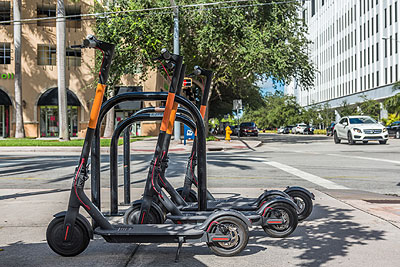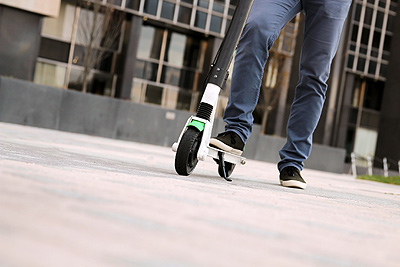The Safety and Liability Concerns Around Jump Electric Scooter Sharing Programs in
Davis
The increase in injuries illustrates an urgent need for regulations on e-scooter sharing programs
 In a recent visit to San Diego, where a Jump electric scooters share program is now available, I witnessed the danger to personal safety and the potential legal complications that can be caused by this new mode of transportation.
In a recent visit to San Diego, where a Jump electric scooters share program is now available, I witnessed the danger to personal safety and the potential legal complications that can be caused by this new mode of transportation.
The riders of these rental jump electric scooters jammed in and out of traffic and failed to comply with traffic laws, making it difficult for drivers to anticipate their unpredictable movements. Their movements are prone to causing jump electric scooter accidents and injuries.
I have also seen folks piling out of bars, not completely sober, and hopping onto these jump electric scooters. Their erratic behaviors could endanger them as well as drivers and pedestrians.
There’s no regulation to restrict the availability of these rental scooters, so there could be a large number on the road at any given moment, creating chaotic situations and jump electric scooter accident and injuries. We also lack the appropriate laws to govern the riders’ behaviors on this new mode of transportation.
Meanwhile, these electric-powered scooters, which have more power than most people expect (and more than is necessary for the intended purposes), are going faster than many users can handle confidently. In fact, I have seen some riders looking shaky and uncomfortable while riding the scooters.
Jump Electric Scooter Accidents and Injuries: A Painful Learning Process
Uber’s purchase of Jump, which adds electric bike and scooter sharing to its portfolio, is just one example of this fast-moving trend.
 Many companies, such as Bird, Lime, and Spin, have introduced jump electric scooter sharing programs in nearly 100 cities across the US in recent months.
Many companies, such as Bird, Lime, and Spin, have introduced jump electric scooter sharing programs in nearly 100 cities across the US in recent months.
As a result, many of these dockless e-scooters are left around public areas, blocking sidewalks, bus stops, train stations, parking areas, and even wheelchair access.
Some riders snaked in and out of traffic – the small bell attached to the handlebar was insufficient to warn drivers of their erratic approaches – while others were zooming down sidewalks at 15 mph, endangering pedestrians’ safety.
Since the introduction of scooter sharing programs in many metropolitan areas across the country, numerous jump electric scooter accidents and injuries have been reported. For example:
- A rider was struck down by an SUV and killed in Washington, D.C.
- Trauma surgeons in cities where e-scooter rental is available are reporting daily occurrences of jump electric scooter-related injuries – from fractured wrists and elbows to concussions or even brain injuries.
- In San Francisco, a 63-year-old woman was injured in a jump electric scooter accident due to a faulty break, which caused her to blow through three intersections at 25 mph.
- A tourist on a jump electric scooter in San Antonio was hit head-on by a pickup truck.
- A jump electric scooter rider ran a red light and hit two pedestrians in Cincinnati, sending both to urgent care.
Jump Electric Scooter Sharing Programs Pose Regulatory Challenges
 The rapid rise of these e-scooter sharing programs has opened up a new territory in traffic laws and personal injury litigation.
The rapid rise of these e-scooter sharing programs has opened up a new territory in traffic laws and personal injury litigation.
While cities are grappling with the legal implications of the widespread use of rental e-scooters, many are also launching pilot programs that introduce these e-scooters onto the road.
For example, the city of Los Angeles has invited several companies to set up scooter sharing programs provided that they adhere to the new rules on permitting, parking, and maintenance.
Some e-scooters sharing companies are also taking steps to introduce safety rules. Bird throttled its scooter speed from 22 mph to 15 mph while offering users free helmet access. The company also puts stickers on all its jump electric scooters listing safety rules, such as that jump electric scooter riders must stay on bike lanes, a license is required for rental, and no double riding is permitted.
However, these rules aren’t legally binding, and there are many grey areas regarding liabilities when a jump electric scooter accident and personal injury occurs.
 Although it’s not the first time that a novel transportation device has surprised regulators (e.g., the Segway), the introduction of ride-sharing programs has made e-scooters widely available at an affordable cost to a large number of users who have little or no experience – a situation we haven’t encountered in the past.
Although it’s not the first time that a novel transportation device has surprised regulators (e.g., the Segway), the introduction of ride-sharing programs has made e-scooters widely available at an affordable cost to a large number of users who have little or no experience – a situation we haven’t encountered in the past.
Given the risks associated with this new transportation device as well as its widespread usage thanks to the low cost and ease of access, we need swift action from regulatory bodies to pass legislation that can bridge the interests among companies, cities, riders, drivers, and pedestrians.